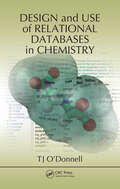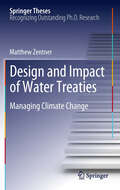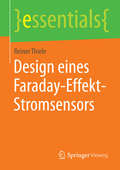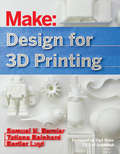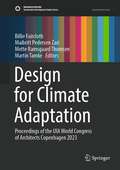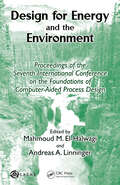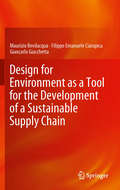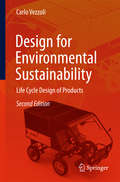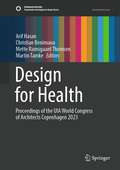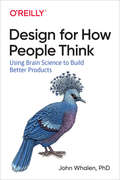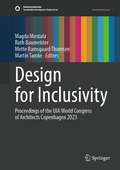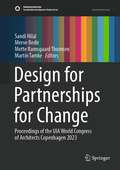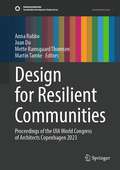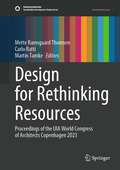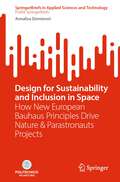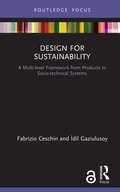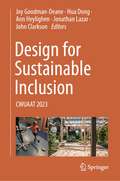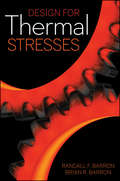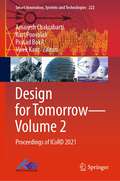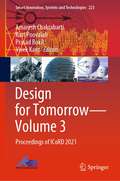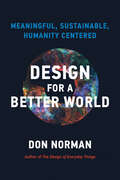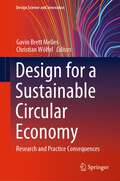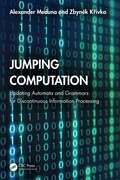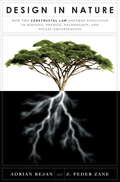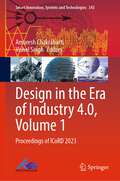- Table View
- List View
Design and Use of Relational Databases in Chemistry
by TJ O'DonnellOptimize Your Chemical DatabaseDesign and Use of Relational Databases in Chemistry helps programmers and users improve their ability to search and manipulate chemical structures and information, especially when using chemical database "cartridges". It illustrates how the organizational, data integrity, and extensibility properties of relational dat
Design and impact of water treaties
by Matthew ZentnerThis study presents a unique way to utilize the existing literature to explain the success of treaties in managing hydrologic stress. Literature-derived core concepts are summarized as seven treaty mechanisms categories (specificity, uncertainty management, enforcement, communications, flexibility, integrativeness, and scale) and are hypothesized as important for shaping the institutional resiliency of a treaty. Treaty design is shown to have a relevant and important role in shaping basin management so that nations may better achieve their goals in a changing climate.
Design eines Faraday-Effekt-Stromsensors (essentials)
by Reiner ThieleReiner Thiele zeigt ausgehend von der prinzipiellen Schaltungsanordnung eines Sensors zur potenzialgetrennten Messung elektrischer Ströme mit dem Faraday-Effekt in Lichtwellenleitern dessen vollständigen Entwurf anhand hergeleiteter Parametergleichungen einschließlich praxisrelevanter Dimensionierungsbeispiele. Außerdem beweist der Autor, dass der für den Sensor funktionsbestimmende lineare Zusammenhang zwischen Messgröße und Messwert der Lösung einer speziellen Riccati-Differenzialgleichung entspricht.
Design for 3D Printing: Scanning, Creating, Editing, Remixing, and Making in Three Dimensions
by Bertier Luyt Samuel N. Bernier Tatiana ReinhardFrance's Le FabShop has extensive experience testing 3D printers and creating digital models for them. From an articulated Makey Robot to a posable elephant model, Samuel N. Bernier and the rest of Le FabShop's team have created some of the most-printed designs in the 3D printing world. This book uses their work to teach you how to get professional results out of a desktop 3D printer without needing to be trained in design. Through a series of tutorials and case studies, this book gives you the techniques to turn a product idea into a 3D model and a prototype. Focusing on free design software and affordable technologies, the exercises in this book are the perfect boost to any beginner looking to start designing for 3D printing. Designing for the tool and finding a good tool to fit the design--these are at the core of the product designer's job, and these are the tools this book will help you master. Foreword by Carl Bass, Autodesk's CEO, a passionate and prolific Maker. In Design For 3D Printing, you'll:Learn the different 3D printing technologiesChoose the best desktop 3D printerDiscover free 3D modeling softwareBecome familiar with 3D scanning solutionsFind out how to go from a bad to a good 3D source file, one that's ready-to-print
Design for Climate Adaptation: Proceedings of the UIA World Congress of Architects Copenhagen 2023 (Sustainable Development Goals Series)
by Mette Ramsgaard Thomsen Martin Tamke Billie Faircloth Maibritt Pedersen ZariThe book provides new perspectives from leading researchers accentuating and examining the central role of the built environment in conceiving and implementing multifaceted solutions for the complex challenges of climate change, revealing critical potentials for architecture and design to contribute in more informed and long-term ways to the urgent transition of our society. The book offers a compilation of peer-reviewed papers that uniquely connects knowledge broadly across practice and academia, from the newest technologies and methods to indigenous knowledge, community engagement, techniques for ecosystem regeneration, nature-based solutions, and more. The book is part of a series of six volumes that explore the agency of the built environment in relation to the SDGs through new research conducted by leading researchers. The series is led by editors Mette Ramsgaard Thomsen and Martin Tamke in collaboration with the theme editors: - Design for Climate Adaptation: Billie Faircloth and Maibritt Pedersen Zari- Design for Rethinking Resources: Carlo Ratti and Mette Ramsgaard Thomsen (Eds.)- Design for Resilient Communities: Anna Rubbo and Juan Du (Eds.)- Design for Health: Arif Hasan and Christian Benimana (Eds.)- Design for Inclusivity: Magda Mostafa and Ruth Baumeister (Eds.)- Design for Partnerships for Change: Sandi Hilal and Merve Bedir (Eds.)
Design for Energy and the Environment: Proceedings of the Seventh International Conference on the Foundations of Computer-Aided Process Design
by Mahmoud M. El-Halwagi Andreas A. LinningerAn examination of systematic techniques for the design of sustainable processes and products, this book covers reducing energy consumption, preventing pollution, developing new pathways for biofuels, and producing environmentally friendly and high-quality products. It discusses innovative design approaches and technological pathways that impact ene
Design for Environment as a Tool for the Development of a Sustainable Supply Chain
by Maurizio Bevilacqua Filippo Emanuele Ciarapica Giancarlo GiacchettaEnvironmental Design is becoming an increasingly significant agenda for many manufacturing companies and yet there is no standard to their approaches, strategies or their levels of execution. Applying Design for Environment (DfE) methodologies to develop a more sustainable supply chain has formed procedures and techniques which allow designers to integrate these methods with environmental supply chain management. Design for Environment as a Tool for the Development of a Sustainable Supply Chain aims to define relevant target specifications for a product throughout its life cycle; from conception and design to the end of its operating life. Be considering this new approach to the supply chain, environmental responsiveness can work in tandem with sounds business management. The usual focus on suppliers, manufacturers and customers is expanded in Design for Environment as a Tool for the Development of a Sustainable Supply Chain to include stakeholders such as government bodies and recycling companies. The influence of these additional groups is analyzed alongside concepts such as: Product life cycle development aimed at environmental impact minimization; Supplier selection and management based on environmental criteria; and Marketing and communication choices which increase the value of environmentally sensitive products. By including several case studies alongside theoretical topics, Design for Environment as a Tool for the Development of a Sustainable Supply Chains acts as a foundation for professionals across the supply chain, from industrial designers to marketing and sales departments, who are involved in environmental issues.
Design for Environmental Sustainability: Life Cycle Design Of Products
by Carlo Arnaldo VezzoliThis volume is a technical and operative contribution to the United Nations "Decade on Education for Sustainable Development" (2005-2014), aiding the development of a new generation of designers, responsible and able in the task of designing environmentally sustainable products. The book provides a comprehensive framework and a practical tool to support the design process. This is an important text for those interested in the product development processes.
Design for Health: Proceedings of the UIA World Congress of Architects Copenhagen 2023 (Sustainable Development Goals Series)
by Mette Ramsgaard Thomsen Martin Tamke Arif Hasan Christian BenimanaThe book provides new perspectives from leading researchers accentuating and examining the central role of the built environment in conceiving and implementing multifaceted solutions to the complex challenges of physical and mental health, revealing critical potentials for architecture and design to contribute in more informed and long-term ways to the urgent transition of our society. The volume book offers a compilation of peer-reviewed papers that uniquely connects knowledge and criticality broadly across practice and academia; from new technologies, theories, and methods to community -engaged practice on many scales, and more. The book is part of a series of six volumes that explore the agency of the built environment in relation to the SDGs through new research conducted by leading researchers. The series is led by editors Mette Ramsgaard Thomsen and Martin Tamke in collaboration with the theme editors: - Design for Climate Adaptation: Billie Faircloth and Maibritt Pedersen Zari- Design for Rethinking Resources: Carlo Ratti and Mette Ramsgaard Thomsen (Eds.)- Design for Resilient Communities: Anna Rubbo and Juan Du (Eds.)- Design for Health: Arif Hasan and Christian Benimana (Eds.)- Design for Inclusivity: Magda Mostafa and Ruth Baumeister (Eds.)- Design for Partnerships for Change: Sandi Hilal and Merve Bedir (Eds.)
Design for How People Think: Using Brain Science to Build Better Products
by John WhalenUser experience doesn’t happen on a screen; it happens in the mind, and the experience is multidimensional and multisensory. This practical book will help you uncover critical insights about how your customers think so you can create products or services with an exceptional experience.Corporate leaders, marketers, product owners, and designers will learn how cognitive processes from different brain regions form what we perceive as a singular experience. Author John Whalen shows you how anyone on your team can conduct "contextual interviews" to unlock insights. You’ll then learn how to apply that knowledge to design brilliant experiences for your customers.Learn about the "six minds" of user experience and how each contributes to the perception of a singular experienceFind out how your team—without any specialized training in psychology—can uncover critical insights about your customers’ conscious and unconscious processesLearn how to immediately apply what you’ve learned to improve your products and servicesExplore practical examples of how the Fortune 100 used this system to build highly successful experiences
Design for Inclusivity: Proceedings of the UIA World Congress of Architects Copenhagen 2023 (Sustainable Development Goals Series)
by Mette Ramsgaard Thomsen Martin Tamke Magda Mostafa Ruth BaumeisterThe book provides new perspectives from leading experts examining the role of architects and urbanists in designing for inclusivity in our built environment. By focusing on themes of gender, race and ethnicity, ability, neurodiversity, age, poverty and socio-economy and the non-human, the book tackles the complex challenges that designers and scholars encounter and need to address in their works. The volume offers a diverse compilation of peer-reviewed papers related to architecture for inclusivity in various different formats, ranging from visual essays, argumentative papers and scholastic texts. It presents the notion of "availability", a concept which works to challenge the "othering" inherent in notions of inclusion and accessibility. In its introduction it presents a critical discourse around the challenges and potentials lying in the design for availability targeted towards a systemic change of our societies. The book is part of a series of six volumes that explore the agency of the built environment in relation to the SDGs through new research conducted by leading researchers. The series is led by editors Mette Ramsgaard Thomsen and Martin Tamke in collaboration with the theme editors: - Design for Climate Adaptation: Billie Faircloth and Maibritt Pedersen Zari - Design for Rethinking Resources: Carlo Ratti and Mette Ramsgaard Thomsen (Eds.) - Design for Resilient Communities: Anna Rubbo and Juan Du (Eds.) - Design for Health: Arif Hasan and Christian Benimana (Eds.) - Design for Inclusivity: Magda Mostafa and Ruth Baumeister (Eds.) - Design for Partnerships for Change: Sandi Hilal and Merve Bedir (Eds.)
Design for Partnerships for Change: Proceedings of the UIA World Congress of Architects Copenhagen 2023 (Sustainable Development Goals Series)
by Mette Ramsgaard Thomsen Martin Tamke Sandi Hilal Merve BedirArchitecture has played a very important role in colonization of the society and the earth, and today we have the urgent task to crack the theory and practice of this same Architecture. We can achieve this only by working collectively towards reframing concepts that has been at the centre of a dominant universalist western knowledge creation. Rethinking and reframing the ideals of community, participation, commons, agency, design, and land, this book puts forward a collective effort to shift the centre of architectural thinking and practice, and create as many ways possible to understand our role as architects today. We acknowledge unrecognized practices by bringing back everyday-life experiences, different paths and forms of knowledge production and storytelling that inform our understanding of architecture. The book is part of a series of six volumes that explore the agency of the built environment in relation to the SDGs through new research conducted by leading researchers. The series is led by editors Mette Ramsgaard Thomsen and Martin Tamke in collaboration with the theme editors: - Design for Climate Adaptation: Billie Faircloth and Maibritt Pedersen Zari - Design for Rethinking Resources: Carlo Ratti and Mette Ramsgaard Thomsen (Eds.) - Design for Resilient Communities: Anna Rubbo and Juan Du (Eds.) - Design for Health: Arif Hasan and Christian Benimana (Eds.) - Design for Inclusivity: Magda Mostafa and Ruth Baumeister (Eds.) - Design for Partnerships for Change: Sandi Hilal and Merve Bedir (Eds.)
Design for Resilient Communities: Proceedings of the UIA World Congress of Architects Copenhagen 2023 (Sustainable Development Goals Series)
by Mette Ramsgaard Thomsen Martin Tamke Anna Rubbo Juan DuThe book provides new perspectives from leading researchers accentuating and examining the central role of the built environment in conceiving and implementing multifaceted solutions for the complex challenges of creating resilient communities, revealing critical potentials for architecture and design to contribute in more informed and long-term ways to the urgent transition of our society. The volume offers a compilation of peer-reviewed papers that uniquely connects knowledge and criticality broadly across practice and academia; from new technologies, theories and methods to community engaged practice on many scales, and more. The book is part of a series of six volumes that explore the agency of the built environment in relation to the SDGs through new research conducted by leading researchers. The series is led by editors Mette Ramsgaard Thomsen and Martin Tamke in collaboration with the theme editors: - Design for Climate Adaptation: Billie Faircloth and Maibritt Pedersen Zari - Design for Rethinking Resources: Carlo Ratti and Mette Ramsgaard Thomsen (Eds.) - Design for Resilient Communities: Anna Rubbo and Juan Du (Eds.) - Design for Health: Arif Hasan and Christian Benimana (Eds.) - Design for Inclusivity: Magda Mostafa and Ruth Baumeister (Eds.) - Design for Partnerships for Change: Sandi Hilal and Merve Bedir (Eds.)
Design for Rethinking Resources: Proceedings of the UIA World Congress of Architects Copenhagen 2023 (Sustainable Development Goals Series)
by Carlo Ratti Mette Ramsgaard Thomsen Martin TamkeThe book provides new perspectives from leading researchers accentuating and examining the central role of the built environment in conceiving and implementing multifaceted solutions for the complex challenges of our understanding of planetary resources and circularity, revealing critical potentials for architecture and design to contribute in more informed and long-term ways to the urgent transition of our society. The book offers a compilation of peer-reviewed papers that uniquely connects knowledge broadly across practice and academia; from the newest technologies and methods such as the role of digital modelling, analysis, and fabrication in circular design, i.e. material passports, cyber-physical augmentation, and LCA to the potentials of growing and harvesting biomass materials, engaging waste streams in material production and more, all in context of economic, social, and ecological potentials and consequences. The book is part of a series of six volumes that explore the agency of the built environment in relation to the SDGs through new research conducted by leading researchers. The series is led by editors Mette Ramsgaard Thomsen and Martin Tamke in collaboration with the theme editors: - Design for Climate Adaptation: Billie Faircloth and Maibritt Pedersen Zari - Design for Rethinking Resources: Carlo Ratti and Mette Ramsgaard Thomsen (Eds.) - Design for Resilient Communities: Anna Rubbo and Juan Du (Eds.) - Design for Health: Arif Hasan and Christian Benimana (Eds.) - Design for Inclusivity: Magda Mostafa and Ruth Baumeister (Eds.) - Design for Partnerships for Change: Sandi Hilal and Merve Bedir (Eds.)
Design for Sustainability and Inclusion in Space: How New European Bauhaus Principles Drive Nature & Parastronauts Projects (SpringerBriefs in Applied Sciences and Technology)
by Annalisa DominoniThis book offers a cutting-edge perspective of design for space to increase astronauts’ wellbeing and performance creating a more sustainable and inclusive environment, but without to forget beauty. The relevant aspect is that these design principles are now also supported and promoted by the European Community with the New European Bauhaus project. It is legitimate to affirm that Space Design is a precursor and inspiring these principles. Space exploration has shown us how results of space research inspire management policies addressing important earth issues such as the responsible use of resources as well as ethical behavior leading to sustainable and inclusive choices. The International Space Station (ISS) is the most successful virtuous example of circular economy and sustainability by almost totally recycling the waste produced. Recently the European Space Agency (ESA) launched the first call for “parastronauts” opening the fly possibilities to people with physical disabilities and thus affirming the principle of inclusion in space. Thanks to design—a bridge between science, technology, and beauty—space opens up to new creative experiments, placing the human being at the center of the interplanetary exploration programs to ensure extra-terrestrial habitats safer, more comfortable, and efficient, where crew will feel “like at home”.
Design for Sustainability: A Multi-level Framework from Products to Socio-technical Systems (Routledge Focus on Environment and Sustainability)
by Fabrizio Ceschin İdil GaziulusoyThis book discusses the most significant ways in which design has been applied to sustainability challenges using an evolutionary perspective. It puts forward an innovation framework that is capable of coherently integrating multiple design for sustainability (DfS) approaches developed so far. It is now widely understood that design can and must play a crucial role in the societal transformations towards sustainability. Design can in fact act as a catalyst to trigger and support innovation, and can help to shape the world at different levels: from materials to products, product–service systems, social organisations and socio-technical systems. This book offers a unique perspective on how DfS has evolved in the past decades across these innovation levels, and provides insights on its promising and necessary future development directions. For design scholars, this book will trigger and feed the academic debate on the evolution of DfS and its next research frontiers. For design educators, the book can be used as a supporting tool to design courses and programmes on DfS. For bachelor’s and master’s level design, engineering and management students, the book can be a general resource to provide an understanding of the historical evolution of DfS. For design practitioners and businesses, the book offers a rich set of practical examples, design methods and tools to apply the various DfS approaches in practice, and an innovation framework which can be used as a tool to support change in organisations that aim to integrate DfS in their strategy and processes.
Design for Sustainable Inclusion: CWUAAT 2023
by John Clarkson Jonathan Lazar Ann Heylighen Hua Dong Joy Goodman-DeaneThis book, Design for Sustainable Inclusion, was inspired and informed by the United Nations Sustainable Development Goals. These include, among others, ‘good health and well-being’, ‘reduced inequalities’ and ‘sustainable cities and communities’. Addressing this challenge requires a cross-disciplinary approach and close collaboration with many stakeholders. The Cambridge Workshop on Universal Access and Assistive Technology (CWUAAT) 2023 invited participants from a wide variety of disciplines to contribute to the discussion on this topic.This book represents the papers presented at this conference, chosen by peer review by an international panel of currently active researchers. The chapters within the book provide a unique insight into current national and international research in the fields of inclusive design, universal access, and assistive and rehabilitative technology. The main sections of the book reflect the following key themes:• Understanding people• Designing for an ageing population• Inclusive built environments• Healthcare• Assistive technology• Design methods• Education and trainingWe hope that this book will be useful to researchers, teachers, students and the general public who are interested in inclusive design and sustainable development.
Design for Thermal Stresses
by Randall F. Barron Brian R. BarronThe tools engineers need for effective thermal stress design Thermal stress concerns arise in many engineering situations, from aerospace structures to nuclear fuel rods to concrete highway slabs on a hot summer day. Having the tools to understand and alleviate these potential stresses is key for engineers in effectively executing a wide range of modern design tasks. Design for Thermal Stresses provides an accessible and balanced resource geared towards real-world applications. Presenting both the analysis and synthesis needed for accurate design, the book emphasizes key principles, techniques, and approaches for solving thermal stress problems. Moving from basic to advanced topics, chapters cover: Bars, beams, and trusses from a "strength of materials" perspective Plates, shells, and thick-walled vessels from a "theory of elasticity" perspective Thermal buckling in columns, beams, plates, and shells Written for students and working engineers, this book features numerous sample problems demonstrating concepts at work. In addition, appendices include important SI units, relevant material properties, and mathematical functions such as Bessel and Kelvin functions, as well as characteristics of matrices and determinants required for designing plates and shells. Suitable as either a working reference or an upper-level academic text, Design for Thermal Stresses gives students and professional engineers the information they need to meet today's thermal stress design challenges.
Design for Tomorrow—Volume 2: Proceedings of ICoRD 2021 (Smart Innovation, Systems and Technologies #222)
by Amaresh Chakrabarti Ravi Poovaiah Prasad Bokil Vivek KantThis book showcases cutting-edge research papers from the 8th International Conference on Research into Design (ICoRD 2021) written by eminent researchers from across the world on design processes, technologies, methods and tools, and their impact on innovation, for supporting design for a connected world. The theme of ICoRD‘21 has been “Design for Tomorrow”. The world as we know it in our times is increasingly becoming connected. In this interconnected world, design has to address new challenges of merging the cyber and the physical, the smart and the mundane, the technology and the human. As a result, there is an increasing need for strategizing and thinking about design for a better tomorrow. The theme for ICoRD’21 serves as a provocation for the design community to think about rapid changes in the near future to usher in a better tomorrow. The papers in this book explore these themes, and their key focus is design for tomorrow: how are products and their development be addressed for the immediate pressing needs within a connected world? The book will be of interest to researchers, professionals and entrepreneurs working in the areas on industrial design, manufacturing, consumer goods, and industrial management who are interested in the new and emerging methods and tools for design of new products, systems and services.
Design for Tomorrow—Volume 3: Proceedings of ICoRD 2021 (Smart Innovation, Systems and Technologies #223)
by Amaresh Chakrabarti Ravi Poovaiah Prasad Bokil Vivek KantThis book showcases cutting-edge research papers from the 8th International Conference on Research into Design (ICoRD 2021) written by eminent researchers from across the world on design processes, technologies, methods and tools, and their impact on innovation, for supporting design for a connected world. The theme of ICoRD‘21 has been “Design for Tomorrow”. The world as we know it in our times is increasingly becoming connected. In this interconnected world, design has to address new challenges of merging the cyber and the physical, the smart and the mundane, the technology and the human. As a result, there is an increasing need for strategizing and thinking about design for a better tomorrow. The theme for ICoRD’21 serves as a provocation for the design community to think about rapid changes in the near future to usher in a better tomorrow. The papers in this book explore these themes, and their key focus is design for tomorrow: how are products and their development be addressed for the immediate pressing needs within a connected world? The book will be of interest to researchers, professionals and entrepreneurs working in the areas on industrial design, manufacturing, consumer goods, and industrial management who are interested in the new and emerging methods and tools for design of new products, systems and services.
Design for a Better World: Meaningful, Sustainable, Humanity Centered
by Donald A. NormanHow human behavior brought our world to the brink, and how human behavior can save us.The world is a mess. Our dire predicament, from collapsing social structures to the climate crisis, has been millennia in the making and can be traced back to the erroneous belief that the earth&’s resources are infinite. The key to change, says Don Norman, is human behavior, covered in the book&’s three major themes: meaning, sustainability, and humanity-centeredness. Emphasize quality of life, not monetary rewards; restructure how we live to better protect the environment; and focus on all of humanity. Design for a Better World presents an eye-opening diagnosis of where we&’ve gone wrong and a clear prescription for making things better.Norman proposes a new way of thinking, one that recognizes our place in a complex global system where even simple behaviors affect the entire world. He identifies the economic metrics that contribute to the harmful effects of commerce and manufacturing and proposes a recalibration of what we consider important in life. His experience as both a scientist and business executive gives him the perspective to show how to make these changes while maintaining a thriving economy. Let the change begin with this book before it&’s too late
Design for a Sustainable Circular Economy: Research and Practice Consequences (Design Science and Innovation)
by Gavin Brett Melles Christian WölfelThis multi-authored book aims to illustrate the social, economic, and ecological factors that should determine and be determined by design in the implementation of a sustainable circular economy and society. We take design to refer to a continuum of perspectives and applications from industrial design to policy design, and this broad perspective invites theoretical and methodological contributions from a range of fields. In addition to bringing scholarly diversity to circularity, we expand and challenge the mainstream circular economy narrative of material efficiencies and green growth to include the demands of inclusive growth and ecological boundaries consistent with sustainable development. Readers from within and beyond design, conscious of the limitations of circular green growth will find new inspiration in this book regarding the nature of a sustainable circular economy and society and the broad design agenda that must be implemented to enable a just and informed circular transition.
Design for the Unthinkable World: Strange Ecology and Unwelcome Change (Design Research for Change)
by Craig Bremner Giovanni Innella A. Paul RodgersThis edited book contests that if design’s raison d'être is to make things better, then the object of design has always been, remains and can only be a changed world and our relationship to it – the world-for-us.Each chapter was written by carefully selected researchers and practitioners who span geographical, disciplinary, and methodological boundaries in their work. Contributors skilfully examine the case that, while this once might have been seen to be a worthy objective (how else to effect a preferred state and/or pursue the project for the better world?), now the role of designing must cease to service design for change in the manner in which it has been doing. Chapters explore how designing itself might change to explore the possibilities that might exist for the design of what-might-not-become in an unthinkable-world; what Eugene Thacker calls a world-without-us. This world-without-us does not mean a world devoid of humans or an interstellar world, but a world we project that continues to revolve around the sun but no longer revolves around us.This book will be of interest to scholars working in design research, design ecology, product design, service design, experience design, architecture, and information design.
Design in Nature: How the Constructal Law Governs Evolution in Biology, Physics, Technology, and Social Organization
by Adrian Bejan J. Peder ZaneIn this groundbreaking book, Adrian Bejan takes the recurring patterns in nature--trees, tributaries, air passages, neural networks, and lightning bolts--and reveals how a single principle of physics, the Constructal Law, accounts for the evolution of these and all other designs in our world. Everything--from biological life to inanimate systems--generates shape and structure and evolves in a sequence of ever-improving designs in order to facilitate flow. River basins, cardiovascular systems, and bolts of lightning are very efficient flow systems to move a current--of water, blood, or electricity. Likewise, the more complex architecture of animals evolve to cover greater distance per unit of useful energy, or increase their flow across the land. Such designs also appear in human organizations, like the hierarchical "flowcharts" or reporting structures in corporations and political bodies. All are governed by the same principle, known as the Constructal Law, and configure and reconfigure themselves over time to flow more efficiently. Written in an easy style that achieves clarity without sacrificing complexity, Design in Nature is a paradigm-shifting book that will fundamentally transform our understanding of the world around us.
Design in the Era of Industry 4.0, Volume 1: Proceedings of ICoRD 2023 (Smart Innovation, Systems and Technologies #343)
by Amaresh Chakrabarti Vishal SinghThis book showcases cutting-edge research papers from the 9th International Conference on Research into Design (ICoRD 2023) – the largest in India in this area – written by eminent researchers from across the world on design processes, technologies, methods and tools, and their impact on innovation, for supporting design for a connected world. The theme of ICoRD’23 has been ‘Design in the Era of Industry 4.0’. Industry 4.0 signifies the fourth industrial revolution. The first industrial revolution was driven by the introduction of mechanical power such as steam and water engines to replace human and animal labour. The second industrial revolution involved introduction of electrical power and organised labour. The third industrial revolution was powered by introduction of industrial automation. The fourth industrial revolution involves introduction of a combination of technologies to enable connected intelligence and industrial autonomy. The introduction of Industry 4.0 dramatically changes the landscape of innovation, and the way design, the engine of innovation, is carried out. The theme of ICoRD’23 - ‘Design in the Era of Industry 4.0’ –explores how Industry 4.0 concepts and technologies influence the way design is conducted, and how methods, tools, and approaches for supporting design can take advantage of this transformational change that is sweeping across the world. The book is of interest to researchers, professionals, and entrepreneurs working in the areas on industrial design, manufacturing, consumer goods, and industrial management who are interested in the new and emerging methods and tools for design of new products, systems, and services.
